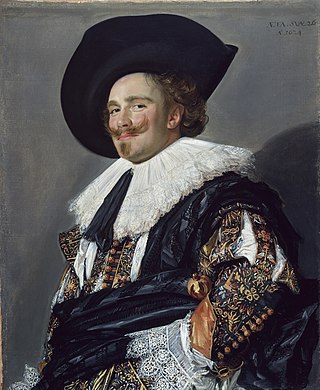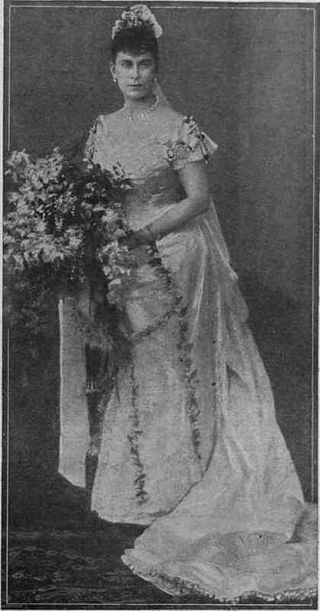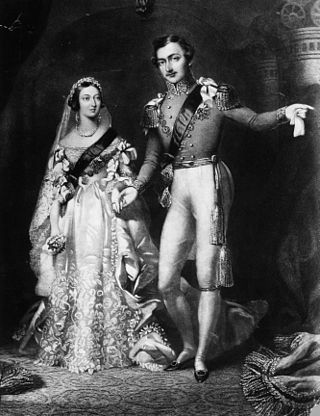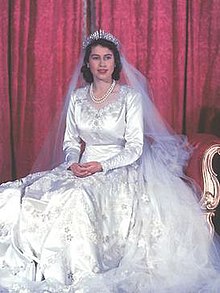
Sir Norman Bishop Hartnell was a leading British fashion designer, best known for his work for the ladies of the royal family. Hartnell gained the Royal Warrant as Dressmaker to Queen Elizabeth in 1940, and Royal Warrant as Dressmaker to Queen Elizabeth II in 1957. Princess Beatrice also wore a dress designed for Queen Elizabeth II by Hartnell for her wedding in 2020.

A wedding dress or bridal gown is the dress worn by the bride during a wedding ceremony. The color, style and ceremonial importance of the gown can depend on the religion and culture of the wedding participants. In Western culture, the wedding dress is most commonly white, a fashion made popular by Queen Victoria when she married in 1840. In Eastern cultures, brides often choose red to symbolize auspiciousness.

An evening gown, evening dress or gown is a long dress usually worn at formal occasions. The drop ranges from ballerina, tea, to full-length. Such gowns are typically worn with evening gloves. Evening gowns are usually made of luxurious fabrics such as chiffon, velvet, satin, or organza. Silk is a popular fibre for many evening gowns. Although the terms are used interchangeably, ball gowns and evening gowns differ in that a ball gown will always have a full skirt and a fitted bodice, while an evening gown can be any silhouette—sheath, mermaid, fit and flare, A-line, or trumpet-shaped—and may have straps, halters or even sleeves.

Fashion in the period 1600–1650 in Western clothing is characterized by the disappearance of the ruff in favour of broad lace or linen collars. Waistlines rose through the period for both men and women. Other notable fashions included full, slashed sleeves and tall or broad hats with brims. For men, hose disappeared in favour of breeches.

Fashion in the period 1500–1550 in Europe is marked by very thick, big and voluminous clothing worn in an abundance of layers. Contrasting fabrics, slashes, embroidery, applied trims, and other forms of surface ornamentation became prominent. The tall, narrow lines of the late Medieval period were replaced with a wide silhouette, conical for women with breadth at the hips and broadly square for men with width at the shoulders. Sleeves were a center of attention, and were puffed, slashed, cuffed, and turned back to reveal contrasting linings.

The wedding of Princess Elizabeth and Philip Mountbatten took place on Thursday 20 November 1947 at Westminster Abbey in London, United Kingdom. The bride was the elder daughter of King George VI and Queen Elizabeth as well as the heir presumptive to the British throne. Although Philip was born a prince of Greece and Denmark, he stopped using these foreign titles on his adoption of British nationality four months before the announcement of their marriage. On the morning of the wedding, he was made Duke of Edinburgh, Earl of Merioneth and Baron Greenwich.

The wedding dress worn by Catherine Middleton at her wedding to Prince William on 29 April 2011 was designed by English designer Sarah Burton, creative director of the luxury fashion house Alexander McQueen.

Lady Diana Spencer's bridal gown was an ivory silk taffeta and antique lace gown, with a 25-foot (7.6 m) train and a 153 yards (140 m) tulle veil, valued then at £9,000. It was worn at Diana's wedding to Charles, Prince of Wales in 1981 at St Paul's Cathedral. It became one of the most famous dresses in the world, and was considered one of the most closely guarded secrets in fashion history.

Queen Elizabeth II's coronation took place on 2 June 1953. Ordered in October 1952, her gown took eight months of research, design, workmanship, and intricate embroidery to complete. It featured the floral emblems of the countries of the United Kingdom and those of the other states within the Commonwealth of Nations, including the English Tudor rose, Scots thistle, Welsh leek, Irish shamrock, Canadian maple leaf, Australian wattle, New Zealand silver fern, South African protea, Indian lotus flower for India, the Lotus flower of Ceylon, and Pakistan's wheat, cotton, and jute.

The wedding dress of Princess Alexandra of Denmark was worn at her wedding to Albert Edward, Prince of Wales on 10 March 1863 in St George's Chapel, Windsor Castle. It was the first in British royal history to be photographed while being worn. The gown was made by London dressmaker Mrs James of Belgravia. It is now part of the British Royal Collection. In 2011, the dress was part of a display of royal wedding dresses at Kensington Palace.

The wedding dress of Princess Victoria Mary of Teck is the gown worn by the future Queen Mary at her wedding to Prince George, Duke of York on 6 July 1893 at the Chapel Royal, St. James's Palace, in London. The dress now belongs to the British Royal Collection and is part of a collection of royal wedding dresses at Kensington Palace in London.

Queen Victoria of the United Kingdom married Prince Albert of Saxe-Coburg and Gotha on 10 February 1840. She chose to wear a white wedding dress made from heavy silk satin, making her one of the first women to wear white for their wedding. The Honiton lace used for her wedding dress proved an important boost to Devon lace-making. Queen Victoria has been credited with starting the tradition of white weddings and white bridal gowns, although she was not the first royal to be married in white.

The wedding dress of the American actress Grace Kelly, worn during her wedding to Rainier III, Prince of Monaco on 19 April 1956, is cited as one of the most elegant and best-remembered bridal gowns of all time, and one of the most famous since the mid 20th century. One author describes the dress as a symbol of "the marital fervor" and a major influence on women who strove to "emulate Kelly's peau de soie and lace masterpiece". It was designed by Helen Rose of MGM. The dress consisted of a bodice with an attached under-bodice and skirt support. There were two petticoats, one being an attached foundation. The wedding attire included a headdress, veil, shoes and the lace- and pearl-encrusted prayer book which she carried down the aisle. To celebrate the 50th anniversary of the wedding, the Philadelphia Museum of Art displayed it at the museum between 1 April and 21 May 2006 and reported it to have been arguably its most popular exhibit.

The wedding dress of Princess Margaret, the sister of Queen Elizabeth II, was worn at her wedding to photographer Antony Armstrong-Jones on 6 May 1960 at Westminster Abbey.
Princess Anne has been married twice, in 1973 and 1992:
The wedding dress of Sophie Rhys-Jones is the bridal gown worn by her at her wedding to Prince Edward, Earl of Wessex on 19 June 1999 at St George's Chapel, Windsor Castle. The dress was designed by Samantha Shaw.

A partlet was a 16th-century fashion accessory. The partlet was a sleeveless garment worn over the neck and shoulders, either worn over a dress or worn to fill in a low neckline.

The wedding of Prince Henry, Duke of Gloucester, and Lady Alice Montagu Douglas Scott took place on Wednesday, 6 November 1935, in the private chapel at Buckingham Palace. A larger public ceremony had been planned for Westminster Abbey, but plans were scaled back after the bride's father, the 7th Duke of Buccleuch, died of cancer on 19 October.
The wedding dress of Princess Beatrice of York worn at her wedding to Edoardo Mapelli Mozzi on 17 July 2020 was designed by the British fashion designer Norman Hartnell, who had originally created the gown for Queen Elizabeth II, the bride's grandmother, in the 1960s. The original dress was altered by the Queen's dressmaker, Angela Kelly, and British fashion designer, Stewart Parvin, who remodelled and fitted the dress for Princess Beatrice.
The wedding dress of Katharine Worsley was worn at her wedding to Prince Edward, Duke of Kent, on 8 June 1961 at York Minster and was designed by Irish designer John Cavanagh.
















